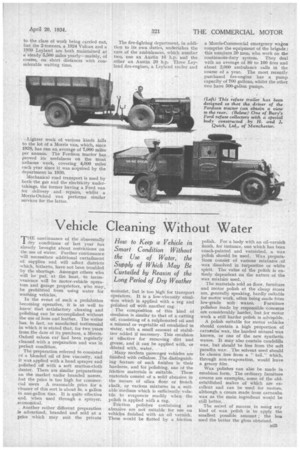Vehicle Cleaning Without Water
Page 39

If you've noticed an error in this article please click here to report it so we can fix it.
How to Keep a Vehicle in Smart Condition Without the Use of Water, the Supply of Which May Be Curtailed by Reason of the Long Period of Dry Weather
THE continuance of the abnormally dry conditions of last year has already brought about restrictions on the use of water. Further continuance will necessitate additional curtailment of supplies and will affect districts which, hitherto, have not been troubled by the shortage. Amongst others who will be put, at the least, to inconvenience will be motor-vehicle operators and garage proprietors, who may, be prohibited from using water for washing vehicles.
In the event of such a prohibition becoming operative, it is as well to know that satisfactory cleaning and polishing can be accomplished without the use of hose and leather. The writer has, in fact, an unsolicited testimonial in which it is stated that, for two years from the date of its purchase, a MorrisOxford saloon car had been regularly cleaned with a preparation and was in perfect condition,
. The preparation referred to consisted of a blended oil of low viscosity, and it was applied with a hand sprayer and polished off with a soft mutton-cloth duster. There are similar preparations on the market under branded names, but the price is too high for commercial users A reasonable price for a cleaner of this sort is about 5s. a gallon in one-gallon tins. It is quite effective and, when used through a sprayer, economical.
, Another rather different preparation is advertised, branded and sold at a price which may suit the private
motorist, but is too high for transport Operators. It is a low-viscosity emulsion which is applied with a rag and polished off with another rag.
The composition of this kind of emulsion is similar to that of a cutting oil, consisting of a sulphonated oil and a mineral or vegetable oil emulsified in water, with a small amount of stabilizer added if necessary. This emulsion is effective for removing dirt and grease, and it can be applied with, or diluted with, water,
.Many modern passenger vehicles are finished with cellulose. Ihe distinguishing feature of such finishes is their hardness, and for Polishing, one of the friction materials is suitable. These materials consist of a mild abrasive in the nature of silica flour or french chalk, or various mixtures in a suitable medium which is sufficiently volatile to evaporate readily when the polish is applied with a rag.
Friction polishes containing an abrasive are not suitable for use on vehicles finished with an oil varnish. These would be flatted by a friction
polish. For a body with an oil-varnish finish, for instance, one which has been coach-painted and varnished, a wax polish should be used. Wax preparations consist of various mixtures .of . wax dissolved in turpentine or white spirit. The value of the polish is entirely dependent on the nature of the wax mixture used.
The materials sold as floor, furniture and motor polish at the cheap stores are, generally speaking, hardly suitable for motor work, often being made from low-grade soft waxes. Furniture polishes made by responsible concerns are considerably harder, but for motor work a still harder polish is advisable.
A polish suitable for motor vehicles should contain a high proportion of earnasffia wax, the hardest natural wax known, or one of the new synthetic waxes. It may also contain candelilla wax, but should be free from the soft paraffin wax. The solvent used should be chosen free from a "tail," which, through non-evaporation, would leave a greasy film.
Wax polishes can also be made in • emulsion form. The ordinary furniture creams are examples, some of the oldestablished makes of which are excellent and can be used for motors, although a cream made from carnauba wax as the main ingredient would be still better.
The secret of success in using any kind of wax polish is to apply the smallest possible amount ; the less used the better the gloss obtained.




























































































